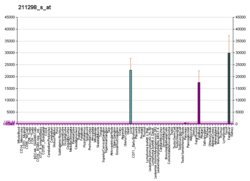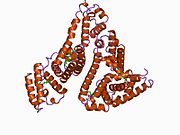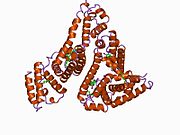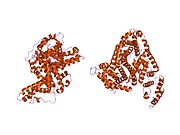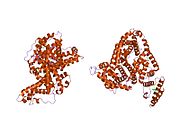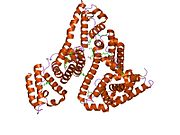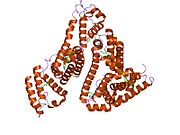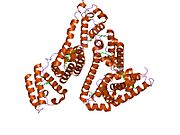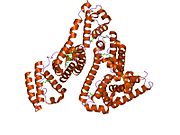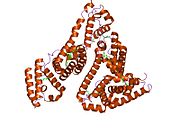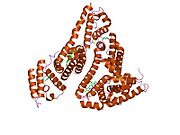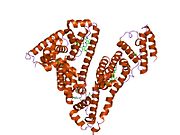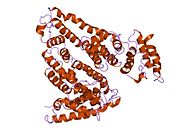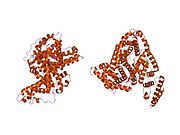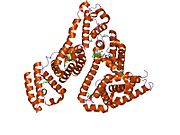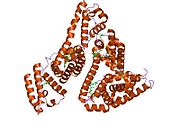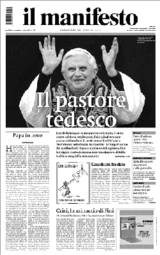인간 혈청 알부민
Human serum albumin| ALB | |||||||||||||||||||||||||||||||||||||||||||||||||||
|---|---|---|---|---|---|---|---|---|---|---|---|---|---|---|---|---|---|---|---|---|---|---|---|---|---|---|---|---|---|---|---|---|---|---|---|---|---|---|---|---|---|---|---|---|---|---|---|---|---|---|---|
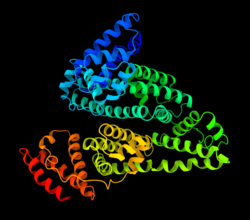 | |||||||||||||||||||||||||||||||||||||||||||||||||||
| |||||||||||||||||||||||||||||||||||||||||||||||||||
| 식별자 | |||||||||||||||||||||||||||||||||||||||||||||||||||
| 에일리어스 | ALB, 혈액알부민, ANALBA, FDAH, PRO0883, PRO0903, PRO1341, 알부민, 세럼알부민, HSA, FDAHT | ||||||||||||||||||||||||||||||||||||||||||||||||||
| 외부 ID | OMIM: 103600 MGI: 87991 HomoloGene: 405 GeneCard: ALB | ||||||||||||||||||||||||||||||||||||||||||||||||||
| |||||||||||||||||||||||||||||||||||||||||||||||||||
| |||||||||||||||||||||||||||||||||||||||||||||||||||
| |||||||||||||||||||||||||||||||||||||||||||||||||||
| |||||||||||||||||||||||||||||||||||||||||||||||||||
| |||||||||||||||||||||||||||||||||||||||||||||||||||
| 위키데이터 | |||||||||||||||||||||||||||||||||||||||||||||||||||
| |||||||||||||||||||||||||||||||||||||||||||||||||||
인간 혈청 알부민은 사람의 혈액에서 발견되는 혈청 알부민이다.그것은 혈장에서 가장 풍부한 단백질로 혈청 단백질의 약 절반을 차지한다.그것은 간에서 생산된다.그것은 물에 녹으며 [citation needed]단량체이다.
알부민은 호르몬, 지방산 및 다른 화합물을 운반하고 pH를 완충하며 종양압력을 유지하며, 다른 기능들 중 하나입니다.
알부민은 간에서 프리프로알부민으로 합성되며, 프리프로알부민은 초기 단백질이 거친 소포체에서 방출되기 전에 제거되는 N 말단 펩타이드를 가지고 있다.프로알부민이라는 제품은 골지 장치에서 분해되어 분비되는 알부민을 생성합니다.
혈청 내 알부민 농도의 기준 범위는 약 35~50g/L(3.5~5.0g/dL)[5]이다.혈청 [6]반감기는 약 21일입니다.그것은 66.5 kDa의 분자량을 가지고 있다.
알부민 유전자는 4번 염색체 4q13.3의 위치에 있으며 이 유전자의 돌연변이는 비정상적인 단백질을 야기할 수 있다.인간 알부민 유전자는 추정 '캡' 부위에서 첫 번째 폴리(A) 부가 부위까지의 길이가 16,961 뉴클레오티드이다.단일 원시 도메인의 3배로 인해 발생한 것으로 생각되는 3개의 도메인 내에 대칭적으로 배치된 15개의 엑손으로 분할됩니다.
인간 혈청 알부민(HSA)은 아미노산 잔기 585개, 술프하이드릴기 1개, 디술피드교 17개로 구성된 상대 분자량 67KDa의 수용성 구상 단량체 혈장 단백질이다.나노입자 운반체 중 HSA 나노입자는 다양한 약물 분자에 결합할 수 있는 능력, 저장 및 생체 내 사용 시 뛰어난 안정성, 독성과 항원성, 생분해성, 재현성, 생산 공정의 스케일업 및 더 나은 조절 난자로 인해 제약업계에서 오랫동안 주목받아 왔다.er 릴리스 속성.또한 알부민 [7]분자의 약물 결합 부위가 많기 때문에 상당한 양의 약물이 입자 매트릭스에 포함될 수 있다.
기능.
- 종양압력 유지
- 갑상선 호르몬을 운반하다
- 다른 호르몬, 특히 지용성 호르몬을 운반합니다.
- 에너지 이용을 위해 지방산("자유" 지방산)을 간 및 근구로 운반합니다.
- 비결합 빌리루빈 운반
- 많은 약물을 운반한다.세럼 알부민 수치는 약물의 반감기에 영향을 줄 수 있다.알부민 결합부위를 위한 약물 간의 경쟁은 약물 중 하나의 자유분율을 증가시킴으로써 약물 상호작용을 일으킬 수 있으며, 그 결과 효력에 영향을 미칠 수 있다.
- 칼슘 이온을 경쟁적으로 결합시킨다(Ca2+)
- 음성의 급성상 단백질인 혈청 알부민은 염증 상태에서 하향 조절된다.따라서 영양상태의 유효한 지표가 아니라 염증상태의 지표이다.
- 엽산의 광분해 방지
- 클로스트리디오이데스 디피실[8] 독소의 병원성 영향 방지
측정.
혈청 알부민은 일반적으로 브로모크레졸 그린이나 브로모크레졸 [9]퍼플 등의 염료에 결합했을 때의 흡광도 변화를 기록함으로써 측정된다.
기준 범위
성인(> 3y.o.)에서 인간 혈청 알부민의 정상 범위는 3.5~5.0g/dL(35~50g/L)이다.3세 미만의 어린이의 경우 정상 범위는 2.9-5.5g/[10]dL로 더 넓다.
저알부민(저알부민혈증)은 간질환, 신증후군, 화상, 단백질 손실 장질환, 흡수불량, 영양실조, 임신후기, 인공물, 유전적 변이 및 악성종양에 [citation needed]의해 발생할 수 있다.
고알부민(고알부민혈증)은 거의 항상 탈수에 의해 발생한다.레티놀(비타민 A) 결핍의 경우, 레티놀은 물로 세포를 부풀리기 때문에 알부민 수치를 높은 정상값(예: 4.9g/dL)으로 올릴 수 있다.(이것은 또한 비타민 A를 너무 많이 섭취하는 것이 독성이 있는 이유이기도 하다.)[11]이 붓기는 심각한 여드름을 치료하는 약인 13-시스 레티노인(이소트레노인)을 사용하는 동안에도 발생할 수 있습니다.실험 결과 올트랜스 레티노산이 인간의 알부민 생산을 [12]조절하는 것으로 나타났다.
병리학
저알부민혈증
저알부민혈증은 혈중 알부민 수치가 [13]낮다는 것을 의미한다.원인은 다음과 같습니다.
- 간질환; 간경변이 가장 흔합니다
- 신장에 의한 과도한 배설(신장증후군 등)
- 장내 과잉 손실(단백질 손실 장병증, 예를 들어 메네트리에병)
- 화상(피부 보호막이 없는 경우 혈장 손실)
- 재분배(혈액[임신 때], 혈관 투과성 증가 또는 림프 클리어런스 감소)
- 급성 질환 상태(음성 급성상 단백질)[14]
- 영양실조와 낭비[15]
- 항문민혈증을 일으키는 돌연변이(매우 드문 경우)
- 거식증(청소년의 가장 일반적인 원인)
고알부민혈증
고알부민혈증은 [16]혈중 알부민 농도가 증가하는 것을 말한다.일반적으로 이 상태는 [16]탈수에 의한 것입니다.고알부민혈증은 고단백질 [17]식단과도 관련이 있다.
의료용
인체 알부민 용액(HSA)은 일반적으로 5~25%의 농도로 의료용으로 사용할 수 있다.
인간 알부민은 종종 손실된 체액을 대체하고 외상, 화상 및 수술 환자의 혈액량을 회복시키는 데 사용됩니다.(식염수에 비해) 알부민 투여가 저혈증 환자나 화상이나 저알부미나혈증으로 [18]위독한 사람들을 위해 생명을 구한다는 강력한 의학적 증거는 없다.알부민의 [18]혜택을 받을 수 있는 위독한 사람들이 있는지도 알려지지 않았다.따라서 Cochrane Collaboration은 임상시험을 [18][19]제외하고는 사용하지 말 것을 권장합니다.
음향액적증발(ADV)에서 알부민은 계면활성제로 사용되기도 한다.ADV는 폐색 [20]치료를 통한 암 치료로 제안되었다.
인간 혈청 알부민은 유리 약물/[21]제에 결합함으로써 잠재적으로 약물/화학적 독성을 역전시키기 위해 사용될 수 있다.
인간 알부민은 또한 분해된 [22]간경화의 치료에 사용될 수 있다.
인간 혈청 알부민은 취약성 [15]지수의 성분으로 사용되어 왔다.
당화
헤모글로빈과[23] 혈청 알부민과[24][25] 같은 인간 혈액 단백질은 주로 리신(때로는 아르기닌) 잔류물의 γ-아미노 그룹과 혈액 내 포도당 분자(마일라드 반응) 사이의 쉬프 염기 형성에 의해 느린 비효소 당화를 겪을 수 있다는 것이 오랫동안 알려져 왔다.이 반응은 항산화제가 [26]있을 때 억제될 수 있다.이 반응은 정상적으로 [24]일어날 수 있지만 당뇨병에서 [25]글리코탄부민 상승이 관찰된다.
당화는 혈청 알부민 [27][28][29][30]단백질의 생물학적 구조와 기능을 변화시킬 가능성이 있다.
또한 당화는 고도 당화 최종 생성물(AGE)의 형성을 초래하여 비정상적인 생물학적 영향을 초래할 수 있다.AGE의 축적은 조직 단백질의 구조와 기능의 변화, 세포 반응의 자극, AGE-단백질에 특정한 수용체를 통한 반응성 산소 중간체의 생성을 통해 조직 손상을 초래한다.AGE는 또한 DNA와 반응하여 돌연변이와 DNA 전이를 일으킨다.단백질과 탄수화물의 열처리는 알레르겐성에 큰 변화를 가져온다.AGE는 항원성이고 조리되거나 저장된 [31]음식에서 발견되는 많은 중요한 네오안티겐을 나타냅니다.그들은 또한 [32]세포에 있는 일산화질소의 정상적인 생성물을 방해한다.
혈청 알부민 구조에는 여러 개의 리신 및 아르기닌 잔기가 있지만, 그 중 극소수만이 당화 [25][33]반응에 참여할 수 있다.
산화
알부민은 대부분의 체액에서 지배적인 단백질이며, Cys34는 체내 유리 티올 중 가장 큰 부분을 나타냅니다.알부민 Cys34 티올은 환원 [34]및 산화 형태로 존재한다.건강한 젊은 성인의 혈장에서는 총 HSA의 70~80%가 환원 형태의 Cys34 유리 술프하이드릴기 또는 메르캅토알부민(HSA-SH)[35]을 함유하고 있다.그러나 산화 스트레스로 특징지어지는 병리 상태 및 노화 과정에서는 산화 형태, 즉 비메르캅토알부민(HNA)이 [36]우세할 수 있다.알부민 티올은 라디칼 하이드록실(.OH), 과산화 수소(H2O2)과peroxynitrite(ONOO.)은 반응성 질소 동물이 되었고, 술펜산 유도암(HSA-SOH)에 Cys34 산화에 mercapto-albumin기 위해 핸들을 재생할 수 있지만 반응성 종의 높은 농도에서 번복할 수 없는 산화에sulfinic(HSA-SO2H)이나 술폰산(HSA-SO3H)affectin으로 이어진다고 보여지고 있다.g그 [37]구조활성산소종(ROS)이 있으면 돌이킬 수 없는 구조적 손상을 유발하고 단백질 활성을 [citation needed]변화시킬 수 있습니다.
신장에 의한 손실
건강한 신장에서는 알부민의 크기와 음전하가 사구체의 배설에서 알부민을 제외합니다.이것은 당뇨병 신증을 포함한 몇몇 질병에서 항상 해당되는 것은 아니다. 당뇨병 신증은 때때로 통제되지 않거나 단백질이 사구체를 통과할 수 있는 장기 당뇨병의 합병증이 될 수 있다.잃어버린 알부민은 간단한 소변 [38]검사로 검출할 수 있습니다.알부민 소실량에 따라 신장기능, 미세알부민뇨, 알부민뇨 등이 나타날 수 있다.
상호 작용
인간 혈청 알부민은 FCGRT와 [39]상호작용하는 것으로 나타났다.
그것은 또한 아직 확인되지 않은 알본딘(gp60), gp18/gp30의 특정 쌍 및 osteonectin, hnRNPs, 칼레티쿨린, 큐빌린,[40] 메가린과 같은 다른 단백질들과 상호작용할 수 있다.
「 」를 참조해 주세요.
레퍼런스
- ^ a b c GRCh38: 앙상블 릴리즈 89: ENSG00000163631 - 앙상블, 2017년 5월
- ^ a b c GRCm38: 앙상블 릴리즈 89: ENSMUSG000029368 - 앙상블, 2017년 5월
- ^ "Human PubMed Reference:". National Center for Biotechnology Information, U.S. National Library of Medicine.
- ^ "Mouse PubMed Reference:". National Center for Biotechnology Information, U.S. National Library of Medicine.
- ^ "Harmonisation of Reference Intervals" (PDF). pathologyharmony.co.uk. Pathology Harmony. Archived from the original (PDF) on 2 August 2013. Retrieved 23 June 2013.
- ^ "Hypoalbuminemia: Background, Pathophysiology, Etiology". Medscape Reference. 2019-11-10. Retrieved 2019-12-22.
- ^ Kouchakzadeh H, Shojaosadati SA, Shokri F (September 2014). "Efficient loading and entrapment of tamoxifen in human serum albumin based nanoparticulate delivery system by a modified desolvation technique". Chemical Engineering Research and Design. 92 (9): 1681–1692. doi:10.1016/j.cherd.2013.11.024.
- ^ di Masi A, Leboffe L, Polticelli F, Tonon F, Zennaro C, Caterino M, et al. (September 2018). "Human Serum Albumin Is an Essential Component of the Host Defense Mechanism Against Clostridium difficile Intoxication". The Journal of Infectious Diseases. 218 (9): 1424–1435. doi:10.1093/infdis/jiy338. PMID 29868851.
- ^ "Albumin: analyte monograph" (PDF). Association for Clinical Biochemistry and Laboratory Medicine. Archived from the original (PDF) on 13 November 2012. Retrieved 23 June 2013.
- ^ "Normal Ranges for Common Laboratory Tests". Archived from the original on 2013-01-14. Retrieved 2007-12-06.
{{cite web}}: CS1 maint: bot: 원래 URL 상태를 알 수 없습니다(링크). 러시 대학교 - ^ Pasantes-Morales H, Wright CE, Gaull GE (December 1984). "Protective effect of taurine, zinc and tocopherol on retinol-induced damage in human lymphoblastoid cells". The Journal of Nutrition. 114 (12): 2256–2261. doi:10.1093/jn/114.12.2256. PMID 6502269.
- ^ Masaki T, Matsuura T, Ohkawa K, Miyamura T, Okazaki I, Watanabe T, Suzuki T (July 2006). "All-trans retinoic acid down-regulates human albumin gene expression through the induction of C/EBPbeta-LIP". The Biochemical Journal. 397 (2): 345–353. doi:10.1042/BJ20051863. PMC 1513275. PMID 16608438.
- ^ Anderson DM (2000). Dorland's illustrated medical dictionary (29th ed.). Philadelphia [u.a.]: Saunders. p. 860. ISBN 978-0721682617.
- ^ Zerbato V, Sanson G, De Luca M, Di Bella S, di Masi A, Caironi P, et al. (2022-04-20). "The Impact of Serum Albumin Levels on COVID-19 Mortality". Infectious Disease Reports. 14 (3): 278–286. doi:10.3390/idr14030034. ISSN 2036-7449. PMC 9149867. PMID 35645213.
- ^ a b Green P, Woglom AE, Genereux P, Daneault B, Paradis JM, Schnell S, et al. (September 2012). "The impact of frailty status on survival after transcatheter aortic valve replacement in older adults with severe aortic stenosis: a single-center experience". JACC. Cardiovascular Interventions. 5 (9): 974–981. doi:10.1016/j.jcin.2012.06.011. PMC 3717525. PMID 22995885.
- ^ a b Busher JT (1990). "Chapter 101: Serum Albumin and Globulin". In Walker HK, Hall WD, Hurst JW (eds.). Clinical methods : the history, physical, and laboratory examinations (3rd ed.). Boston: Butterworths. ISBN 978-0409900774. PMID 21250048.
- ^ Mutlu EA, Keshavarzian A, Mutlu GM (June 2006). "Hyperalbuminemia and elevated transaminases associated with high-protein diet". Scandinavian Journal of Gastroenterology. 41 (6): 759–760. doi:10.1080/00365520500442625. PMID 16716979. S2CID 21264934.
- ^ a b c Roberts I, Blackhall K, Alderson P, Bunn F, Schierhout G (November 2011). "Human albumin solution for resuscitation and volume expansion in critically ill patients". The Cochrane Database of Systematic Reviews (11): CD001208. doi:10.1002/14651858.CD001208.pub4. hdl:2299/5243. PMC 7055200. PMID 22071799.
- ^ Yu YT, Liu J, Hu B, Wang RL, Yang XH, Shang XL, et al. (July 2021). "Expert consensus on the use of human serum albumin in critically ill patients". Chinese Medical Journal. 134 (14): 1639–1654. doi:10.1097/CM9.0000000000001661. PMC 8318641. PMID 34397592.
- ^ Lo AH, Kripfgans OD, Carson PL, Rothman ED, Fowlkes JB (May 2007). "Acoustic droplet vaporization threshold: effects of pulse duration and contrast agent". IEEE Transactions on Ultrasonics, Ferroelectrics, and Frequency Control. 54 (5): 933–946. doi:10.1109/tuffc.2007.339. PMID 17523558. S2CID 11983041.
- ^ Ascenzi P, Leboffe L, Toti D, Polticelli F, Trezza V (August 2018). "Fipronil recognition by the FA1 site of human serum albumin". Journal of Molecular Recognition. 31 (8): e2713. doi:10.1002/jmr.2713. PMID 29656610. S2CID 4894574.
- ^ Caraceni P, Riggio O, Angeli P, Alessandria C, Neri S, Foschi FG, et al. (June 2018). "Long-term albumin administration in decompensated cirrhosis (ANSWER): an open-label randomised trial". Lancet. 391 (10138): 2417–2429. doi:10.1016/S0140-6736(18)30840-7. hdl:2108/208667. PMID 29861076. S2CID 44120418.
- ^ Rahbar S (October 1968). "An abnormal hemoglobin in red cells of diabetics". Clinica Chimica Acta; International Journal of Clinical Chemistry. 22 (2): 296–298. doi:10.1016/0009-8981(68)90372-0. PMID 5687098.
- ^ a b Day JF, Thorpe SR, Baynes JW (February 1979). "Nonenzymatically glucosylated albumin. In vitro preparation and isolation from normal human serum". The Journal of Biological Chemistry. 254 (3): 595–597. doi:10.1016/S0021-9258(17)37845-6. PMID 762083.
- ^ a b c Iberg N, Flückiger R (October 1986). "Nonenzymatic glycosylation of albumin in vivo. Identification of multiple glycosylated sites". The Journal of Biological Chemistry. 261 (29): 13542–13545. doi:10.1016/S0021-9258(18)67052-8. PMID 3759977.
- ^ Jakus V, Hrnciarová M, Cársky J, Krahulec B, Rietbrock N (1999). "Inhibition of nonenzymatic protein glycation and lipid peroxidation by drugs with antioxidant activity". Life Sciences. 65 (18–19): 1991–1993. doi:10.1016/S0024-3205(99)00462-2. PMID 10576452.
- ^ Mohamadi-Nejad A, Moosavi-Movahedi AA, Hakimelahi GH, Sheibani N (September 2002). "Thermodynamic analysis of human serum albumin interactions with glucose: insights into the diabetic range of glucose concentration". The International Journal of Biochemistry & Cell Biology. 34 (9): 1115–1124. doi:10.1016/S1357-2725(02)00031-6. PMID 12009306.
- ^ Shaklai N, Garlick RL, Bunn HF (March 1984). "Nonenzymatic glycosylation of human serum albumin alters its conformation and function". The Journal of Biological Chemistry. 259 (6): 3812–3817. doi:10.1016/S0021-9258(17)43168-1. PMID 6706980.
- ^ Mendez DL, Jensen RA, McElroy LA, Pena JM, Esquerra RM (December 2005). "The effect of non-enzymatic glycation on the unfolding of human serum albumin". Archives of Biochemistry and Biophysics. 444 (2): 92–99. doi:10.1016/j.abb.2005.10.019. PMID 16309624.
- ^ Mohamadi-Nejada A, Moosavi-Movahedi AA, Safariana S, Naderi-Maneshc MH, Ranjbarc B, Farzamid B, Mostafavie H, Larijanif MB, Hakimelahi GH (July 2002). "The thermal analysis of nonezymatic glycosylation of human serum albumin: differential scanning calorimetry and circular dichroism studies". Thermochimica Acta. 389 (1–2): 141–151. doi:10.1016/S0040-6031(02)00006-0.
- ^ Kańska U, Boratyński J (2002). "Thermal glycation of proteins by D-glucose and D-fructose". Archivum Immunologiae et Therapiae Experimentalis. 50 (1): 61–66. PMID 11916310.
- ^ Rojas A, Romay S, González D, Herrera B, Delgado R, Otero K (February 2000). "Regulation of endothelial nitric oxide synthase expression by albumin-derived advanced glycosylation end products". Circulation Research. 86 (3): E50–E54. doi:10.1161/01.RES.86.3.e50. PMID 10679490.
- ^ Garlick RL, Mazer JS (May 1983). "The principal site of nonenzymatic glycosylation of human serum albumin in vivo". The Journal of Biological Chemistry. 258 (10): 6142–6146. doi:10.1016/S0021-9258(18)32384-6. PMID 6853480.
- ^ Kawakami A, Kubota K, Yamada N, Tagami U, Takehana K, Sonaka I, et al. (July 2006). "Identification and characterization of oxidized human serum albumin. A slight structural change impairs its ligand-binding and antioxidant functions". The FEBS Journal. 273 (14): 3346–3357. doi:10.1111/j.1742-4658.2006.05341.x. PMID 16857017. S2CID 12844381.
- ^ Turell L, Carballal S, Botti H, Radi R, Alvarez B (April 2009). "Oxidation of the albumin thiol to sulfenic acid and its implications in the intravascular compartment". Brazilian Journal of Medical and Biological Research = Revista Brasileira de Pesquisas Medicas e Biologicas. 42 (4): 305–311. doi:10.1590/s0100-879x2009000400001. PMID 19330257.
- ^ Rosas-Díaz M, Camarillo-Cadena M, Hernández-Arana A, Ramón-Gallegos E, Medina-Navarro R (June 2015). "Antioxidant capacity and structural changes of human serum albumin from patients in advanced stages of diabetic nephropathy and the effect of the dialysis". Molecular and Cellular Biochemistry. 404 (1–2): 193–201. doi:10.1007/s11010-015-2378-2. PMID 25758354. S2CID 6718332.
- ^ Matsuyama Y, Terawaki H, Terada T, Era S (August 2009). "Albumin thiol oxidation and serum protein carbonyl formation are progressively enhanced with advancing stages of chronic kidney disease". Clinical and Experimental Nephrology. 13 (4): 308–315. doi:10.1007/s10157-009-0161-y. PMID 19363646. S2CID 20886185.
- ^ "Microalbumin Urine Test". WebMD.
- ^ Chaudhury C, Mehnaz S, Robinson JM, Hayton WL, Pearl DK, Roopenian DC, Anderson CL (February 2003). "The major histocompatibility complex-related Fc receptor for IgG (FcRn) binds albumin and prolongs its lifespan". The Journal of Experimental Medicine. 197 (3): 315–322. doi:10.1084/jem.20021829. PMC 2193842. PMID 12566415.
- ^ Merlot AM, Kalinowski DS, Richardson DR (2014). "Unraveling the mysteries of serum albumin-more than just a serum protein". Frontiers in Physiology. 5: 299. doi:10.3389/fphys.2014.00299. PMC 4129365. PMID 25161624.
추가 정보
- Komatsu T, Nakagawa A, Curry S, Tsuchida E, Murata K, Nakamura N, Ohno H (September 2009). "The role of an amino acid triad at the entrance of the heme pocket in human serum albumin for O(2) and CO binding to iron protoporphyrin IX". Organic & Biomolecular Chemistry. 7 (18): 3836–3841. doi:10.1039/b909794e. PMID 19707690.
- Milojevic J, Raditsis A, Melacini G (November 2009). "Human serum albumin inhibits Abeta fibrillization through a "monomer-competitor" mechanism". Biophysical Journal. 97 (9): 2585–2594. Bibcode:2009BpJ....97.2585M. doi:10.1016/j.bpj.2009.08.028. PMC 2770600. PMID 19883602.
- Silva AM, Hider RC (October 2009). "Influence of non-enzymatic post-translation modifications on the ability of human serum albumin to bind iron. Implications for non-transferrin-bound iron speciation". Biochimica et Biophysica Acta. 1794 (10): 1449–1458. doi:10.1016/j.bbapap.2009.06.003. PMID 19505594.
- Otosu T, Nishimoto E, Yamashita S (February 2010). "Multiple conformational state of human serum albumin around single tryptophan residue at various pH revealed by time-resolved fluorescence spectroscopy". Journal of Biochemistry. 147 (2): 191–200. doi:10.1093/jb/mvp175. PMID 19884191.
- Blindauer CA, Harvey I, Bunyan KE, Stewart AJ, Sleep D, Harrison DJ, et al. (August 2009). "Structure, properties, and engineering of the major zinc binding site on human albumin". The Journal of Biological Chemistry. 284 (34): 23116–23124. doi:10.1074/jbc.M109.003459. PMC 2755717. PMID 19520864.
- Juárez J, López SG, Cambón A, Taboada P, Mosquera V (July 2009). "Influence of electrostatic interactions on the fibrillation process of human serum albumin". The Journal of Physical Chemistry B. 113 (30): 10521–10529. doi:10.1021/jp902224d. PMID 19572666.
- Fu BL, Guo ZJ, Tian JW, Liu ZQ, Cao W (August 2009). "[Advanced glycation end products induce expression of PAI-1 in cultured human proximal tubular epithelial cells through NADPH oxidase dependent pathway]". Xi Bao Yu Fen Zi Mian Yi Xue Za Zhi = Chinese Journal of Cellular and Molecular Immunology. 25 (8): 674–677. PMID 19664386.
- Ascenzi P, di Masi A, Coletta M, Ciaccio C, Fanali G, Nicoletti FP, et al. (November 2009). "Ibuprofen impairs allosterically peroxynitrite isomerization by ferric human serum heme-albumin". The Journal of Biological Chemistry. 284 (45): 31006–31017. doi:10.1074/jbc.M109.010736. PMC 2781501. PMID 19734142.
- Sowa ME, Bennett EJ, Gygi SP, Harper JW (July 2009). "Defining the human deubiquitinating enzyme interaction landscape". Cell. 138 (2): 389–403. doi:10.1016/j.cell.2009.04.042. PMC 2716422. PMID 19615732.
- Curry S (August 2002). "Beyond expansion: structural studies on the transport roles of human serum albumin". Vox Sanguinis. 83 (Suppl 1): 315–319. doi:10.1111/j.1423-0410.2002.tb05326.x. PMID 12617161. S2CID 44482133.
- Guo S, Shi X, Yang F, Chen L, Meehan EJ, Bian C, Huang M (September 2009). "Structural basis of transport of lysophospholipids by human serum albumin". The Biochemical Journal. 423 (1): 23–30. doi:10.1042/BJ20090913. PMID 19601929.
- de Jong PE, Gansevoort RT (2009). "Focus on microalbuminuria to improve cardiac and renal protection". Nephron Clinical Practice. 111 (3): c204-10, discussion c211. doi:10.1159/000201568. PMID 19212124.
- Page TA, Kraut ND, Page PM, Baker GA, Bright FV (September 2009). "Dynamics of loop 1 of domain I in human serum albumin when dissolved in ionic liquids". The Journal of Physical Chemistry B. 113 (38): 12825–12830. doi:10.1021/jp904475v. PMID 19711930.
- Roche M, Rondeau P, Singh NR, Tarnus E, Bourdon E (June 2008). "The antioxidant properties of serum albumin". FEBS Letters. 582 (13): 1783–1787. doi:10.1016/j.febslet.2008.04.057. PMID 18474236. S2CID 5364683.
- Wyatt AR, Wilson MR (February 2010). "Identification of human plasma proteins as major clients for the extracellular chaperone clusterin". The Journal of Biological Chemistry. 285 (6): 3532–3539. doi:10.1074/jbc.M109.079566. PMC 2823492. PMID 19996109.
- Cui FL, Yan YH, Zhang QZ, Qu GR, Du J, Yao XJ (February 2010). "A study on the interaction between 5-Methyluridine and human serum albumin using fluorescence quenching method and molecular modeling". Journal of Molecular Modeling. 16 (2): 255–262. doi:10.1007/s00894-009-0548-4. PMID 19588173. S2CID 9042021.
- Caridi G, Dagnino M, Simundic AM, Miler M, Stancic V, Campagnoli M, et al. (March 2010). "Albumin Benkovac (c.1175 A > G; p.Glu392Gly): a novel genetic variant of human serum albumin". Translational Research. 155 (3): 118–119. doi:10.1016/j.trsl.2009.10.001. PMID 20171595.
- Deeb O, Rosales-Hernández MC, Gómez-Castro C, Garduño-Juárez R, Correa-Basurto J (February 2010). "Exploration of human serum albumin binding sites by docking and molecular dynamics flexible ligand-protein interactions". Biopolymers. 93 (2): 161–170. doi:10.1002/bip.21314. PMID 19785033.
- Karahan SC, Koramaz I, Altun G, Uçar U, Topbaş M, Menteşe A, Kopuz M (2010). "Ischemia-modified albumin reduction after coronary bypass surgery is associated with the cardioprotective efficacy of cold-blood cardioplegia enriched with N-acetylcysteine: a preliminary study". European Surgical Research. 44 (1): 30–36. doi:10.1159/000262324. PMID 19955769. S2CID 26699371.
- Jin C, Lu L, Zhang RY, Zhang Q, Ding FH, Chen QJ, Shen WF (October 2009). "Association of serum glycated albumin, C-reactive protein and ICAM-1 levels with diffuse coronary artery disease in patients with type 2 diabetes mellitus". Clinica Chimica Acta; International Journal of Clinical Chemistry. 408 (1–2): 45–49. doi:10.1016/j.cca.2009.07.003. PMID 19615354.




